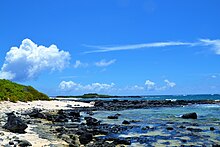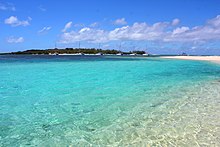Île Plate
Native name: Île Plate | |
|---|---|
 1857 map of Île Plate | |
| Geography | |
| Location | Indian Ocean |
| Coordinates | 19°52′47″S 57°40′05″E / 19.8797°S 57.668°E |
| Area | 2.53 km2 (0.98 sq mi) |
| Length | 1.9 km (1.18 mi) |
| Width | 1.9 km (1.18 mi) |
| Highest point | 95 |
| Administration | |
| Capital and largest city | Port Louis |
| Demographics | |
| Population | 0 |
Île Plate, also known as Flat Island, is a small island in the Indian Ocean off the north coast of Mauritius.[1]
Geography
[edit]
Île Plate is located 11 kilometres (6.8 mi) north of Cap Malheureux, the main island's northernmost point. It is part of the administrative area of Rivière du Rempart District. The small nature reserve of Coin de Mire lies between the two islands.[citation needed]
As its name suggests, Île Plate is low-lying, apart from a bluff, and is in danger of possible submersion due to the historical rise in the sea-level. It covers an area of 2.53 square kilometres (0.98 sq mi). Two small islets, Îlot Gabriel and Pigeon Rock, lie close to the shore of Île Plate.[2] The three sites are national protected areas (Pigeon Rock as part of Islets National Park).[3]
Île Plate is uninhabited, though there is a small army base on the island.[4]
Flora and fauna
[edit]A census conducted in 2007/2008 by the University of Mauritius classified 121 species of vascular plants, many of which are non-native. Among the indigenous plants present, the Latania loddigesii, Pandanus vandermeeschii, Psiadia arguta, as well as the reintroduced Dracaena concinna and Aloe tormentorii, imported from the island of Coin de Mire.[5]
The only mammals on the island are three species of bats: the Mauritian flying fox(Pteropus niger), the Mauritius tomb bat (Taphozous mauritianus) and the Natal free-tailed bat (Mormopterus acetabulosus).[5]
Three species of seabirds nest on the island: the Wedge-tailed shearwater (Ardenna pacifica), the Red-tailed Tropicbird(Phaethon Rubricauda) and the White-tailed Tropicbird (Phaethon lepturus). The rich vegetation of the interior of the island combined with the presence of wetlands also favor the nesting of the striated heron (Butorides striata) and occasionally also attract the Whimbrel (Numenius phaeopus), the plover (Pluvialis squatarola) and the Ruddy turnstone(Arenaria interpres). Some exotic species such as the common myna (Acridotheres tristis), the red-whiskered bulbul (Pycnonotus jocosus) and the House sparrow (Passer domesticus) are present.[5]

The island was once home to the largest population of Bojer's skink (Gongylomorphus bojerii), once very common on the island of Mauritius, and now considered critically endangered. The population was decimated following the arrival of the Asian house shrew (Suncus murinus) on the island.[6] Other reptiles present are the Snake-eyed skink (Cryptoblepharus boutonii), the Ornate day gecko(Phelsuma ornata) and the Lesser night gecko (Nactus coindemirensis). Three exotic species have also been introduced to the island: the geckos Hemidactylus frenatus, Gehyra mutilata and the fossorial snake Indotyphlops braminus(Typhlopidae).[citation needed]
The black rat (R. rattus) population of Gabriel and Flat Island was eradicated in 1995 and 1998, respectively.[7][8]
History
[edit]Île Plate was approached during the Baudin expedition to Australia on March 15, 1801. Jean-Baptiste Bory de Saint-Vincent described it from aboard the Naturaliste: she is "much lower than the others; a beach of limestone makes it remarkable from afar, and appears with a dazzling white hue; the rest of its rocks are reddish or black". To explain these last colors, he refers to a certain Lilet, an engineer officer, who would have visited the reef and who told him he had found the debris of an ancient crater of volcano.[9]
One of Mauritius's few operating lighthouses, built in 1855, is found on the southwest side of the island.[10][11][4]
Flat Island was used as a quarantine station from the mid-19th century to the 1930s. It was reserved for immigrants to Mauritius, mostly indentured labourers, undergoing quarantine for cholera, although it was sometimes used during other epidemic outbreaks such as smallpox and malaria. Infrastructure was built between 1856 and 1870 and included stone and wooden buildings. These buildings comprised living quarters and offices for medical, police, and immigration officials in charge of the quarantine station and barracks for migrants placed in quarantine. Kitchens, stores, toilets, privies, two hospitals, and a distillation plant used for water supply were also constructed. Many of these structures are still preserved, though overgrown. A cemetery located on the southern side of the island is still recognizable for the presence of basalt structures and cairns on the top of some graves.[12][4][13]
Archaeology
[edit]Since 2014, Project MACH (Mauritian Archaeology and Cultural Heritage) of Stanford University in the U.S. has been researching the heritage of Flat Island[14] in collaboration with the Aapravasi Ghat Trust Fund[15] and National Parks and Conservation Services of Mauritius.[16] The primary purpose of the project is to document the remaining structures of the quarantine station, and to perform the overall assessment of archaeological potential of the island. The results will form part of a wider restoration and conservation plan to promote the preservation of this important cultural site. The planned archaeological investigation includes detailed surveys of infrastructure, paths, and architectural features pertaining to the quarantine station as well as the cemetery. Over the years, four archaeological campaigns have been performed through intensive survey and execution of test-pits, in particular around the provision store building, one of the hospitals, and one of the camps that hosted the immigrants during quarantine. Also planned are a geophysical survey of subsoil features, an environmental sampling for geoarchaeological analysis, and a detailed mapping of the island through the use of a drone.[17]
Tourism
[edit]
Île Plate is a popular venue for snorkellers, and access to the island is possible via chartered yacht and catamaran. Pigeon Rock harbors an internationally famous dive site called The Shark Pit where divers can witness sharks swirling within the pit for the rich oxygen available due to the crushing waves against the cliffs of Pigeon Rock.[18]
See also
[edit]References
[edit]- ^ "Flat Island Mauritian Archaeology". mauritianarchaeology.sites.stanford.edu.
- ^ "BirdLife Data Zone". datazone.birdlife.org.
- ^ Islet and Offshore Unit npcs.govmu.org
- ^ a b c "Flat Island" (PDF). Aapravasi Ghat Trust Fund.
- ^ a b c "Flat Island – Gabriel Island System Islet Profiles, Biotope Classifications and Management Plans". Development of Management Plans for the Conservation & Management of Offshore Islets for the Republic of Mauritius. Retrieved October 22, 2016.
- ^ Cole, N. & Payne, C. (2015). "Gongylomorphus bojerii". The IUCN Red List of Threatened Species. 2015. doi:10.2305/IUCN.UK.2015-4.RLTS.T62251A13482733.en. Retrieved October 16, 2016.
- ^ Howald, Gregg; Donlan, C. Josh; Galván, Juan Pablo; Russell, James C.; Parkes, John; Samaniego, Araceli; Wang, Yiwei; Veitch, Dick; Genovesi, Piero; Pascal, Michel; Saunders, Alan (October 2007). "Invasive Rodent Eradication on Islands". Conservation Biology. 21 (5): 1258–1268. doi:10.1111/j.1523-1739.2007.00755.x. ISSN 0888-8892. PMID 17883491. S2CID 6350193.
- ^ Veitch, C. R.; Clout, M. N. (March 18, 2002). Turning the Tide: The Eradication of Invasive Species : Proceedings of the International Conference on Eradication of Island Invasives. IUCN. ISBN 9782831706825 – via Google Books.
- ^ Voyage in the four main islands of the seas of Africa , Jean-Baptiste Bory de Saint-Vincent, 1804.
- ^ Rowlett, Russ. "Lighthouses of Mauritius". The Lighthouse Directory. University of North Carolina at Chapel Hill. Retrieved March 7, 2021.
- ^ "Île Plate (Flat Island) Lighthouse in Cape Malheureux, Mauritius (Google Maps)". Virtual Globetrotting. May 23, 2011.
- ^ Pike, N. (1873), Sub-tropical rambles in the land of the Aphanapteryx. Personal experiences, adventures and wanderings in and around the island of Mauritius, New York: Harper & Brothers Publishers
- ^ *La Quarantaine, Jean-Marie Gustave Le Clézio, Folio, Numéro 2974. L'auteur ne se lasse pas de décrire l'île Plate et son petit frère, l'îlot Gabriel.
- ^ "Mauritian Archaeology". mauritianarchaeology.sites.stanford.edu.
- ^ Fund AGTF [dead link]
- ^ Index NPCS
- ^ Seetah, Krish (May 18, 2016). "Contextualizing Complex Social Contact: Mauritius, a Microcosm of Global Diaspora". Cambridge Archaeological Journal. 26 (2): 265–283. doi:10.1017/S0959774315000414. S2CID 163838882.
- ^ "Islets in Mauritius: Ile Plate – Flat Island". October 2, 2016. Archived from the original on October 2, 2016.


